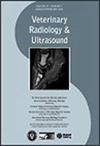脊椎右心指数:评估犬右心室肥大的新放射学方法
IF 1.3
2区 农林科学
Q2 VETERINARY SCIENCES
引用次数: 0
摘要
在兽医学中,右心扩大(RHE)的放射学评估基本上是主观的。本研究旨在评估椎体右心指数(VRHi),将其作为检测犬 RHE 的一种新的定量放射影像学方法。这是一项多中心、回顾性、观察性研究,包括患有 RHE 的狗和对照组狗。所有犬只都必须在同一天进行胸部X光检查和完整的超声心动图检查。根据超声心动图检查结果,右心房增大、右心室增大和/或肥厚是右心增大的定义。在放射学研究中,每个病例的所有放射学切面都被考虑用于测量:右外侧(RL)、左外侧(LL)、腹背(VD)和背腹(DV)。VRHi使用LL、RL、VD和DV视图进行测量。共纳入 204 只狗:其中 91 只患有 RHE,113 只为对照组。与对照组相比,RHE 患犬的 VRHi (RL)、VRHi (LL) 和 VRHi (VD) 明显更高(P < .0001)。VRHi (LL) 的诊断准确率最高(曲线下面积 [AUC] 0.86,P < .0001;临界值≥ 3.5 个椎体,灵敏度 [Se] 71%,特异性 [Sp] 89%),其次是 VRHi (RL)(曲线下面积 [AUC] 0.85,P < .0001; 临界值≥ 3.5 个椎体,Se 68%,Sp 86%)和 VRHi (VD)(AUC 0.80,P = .0004; 临界值≥ 3.0 个椎体,Se 57%,Sp 95%)。总之,LL 和 RL 的外侧 VRHi 以及 VD VRHi 是检测犬 RHE 的有用放射学工具。本文章由计算机程序翻译,如有差异,请以英文原文为准。
The vertebral right heart index: A new radiographic method to assess right heart enlargement in dogs
In veterinary medicine, the radiographic assessment of right heart enlargement (RHE) is essentially subjective. The aim of this study was to evaluate the vertebral right heart index (VRHi) as a new quantitative radiographic method to detect RHE in dogs. This was a multicenter, retrospective, observational study, including dogs with RHE and control dogs. All dogs had to have a thoracic radiographic study and a complete echocardiography on the same day. Right heart enlargement was defined as the presence of right atrial enlargement, right ventricular enlargement, and/or hypertrophy based on echocardiography. For the radiographic study, all the radiographic views available for each case were considered for measurement: right lateral (RL), left lateral (LL), ventrodorsal (VD), and dorsoventral (DV). The VRHi was measured using LL, RL, VD, and DV views. A total of 204 dogs were included: 91 dogs with RHE and 113 control dogs. The VRHi (RL), the VRHi (LL), and the VRHi (VD) were significantly greater in dogs with RHE compared with controls (P < .0001). The best diagnostic accuracy was observed for VRHi (LL) (area under the curve [AUC] 0.86, P < .0001; cutoff ≥ 3.5 vertebrae, sensitivity [Se] 71%, specificity [Sp] 89%), followed by VRHi (RL) (AUC 0.85, P < .0001; cutoff ≥ 3.5 vertebrae, Se 68%, Sp 86%) and VRHi (VD) (AUC 0.80, P = .0004; cutoff ≥ 3.0 vertebrae, Se 57%, Sp 95%). In conclusion, the lateral VRHi in LL and RL and the VD VRHi could represent useful radiological tools for the detection of RHE in dogs.
求助全文
通过发布文献求助,成功后即可免费获取论文全文。
去求助
来源期刊

Veterinary Radiology & Ultrasound
农林科学-兽医学
CiteScore
2.40
自引率
17.60%
发文量
133
审稿时长
8-16 weeks
期刊介绍:
Veterinary Radiology & Ultrasound is a bimonthly, international, peer-reviewed, research journal devoted to the fields of veterinary diagnostic imaging and radiation oncology. Established in 1958, it is owned by the American College of Veterinary Radiology and is also the official journal for six affiliate veterinary organizations. Veterinary Radiology & Ultrasound is represented on the International Committee of Medical Journal Editors, World Association of Medical Editors, and Committee on Publication Ethics.
The mission of Veterinary Radiology & Ultrasound is to serve as a leading resource for high quality articles that advance scientific knowledge and standards of clinical practice in the areas of veterinary diagnostic radiology, computed tomography, magnetic resonance imaging, ultrasonography, nuclear imaging, radiation oncology, and interventional radiology. Manuscript types include original investigations, imaging diagnosis reports, review articles, editorials and letters to the Editor. Acceptance criteria include originality, significance, quality, reader interest, composition and adherence to author guidelines.
 求助内容:
求助内容: 应助结果提醒方式:
应助结果提醒方式:


